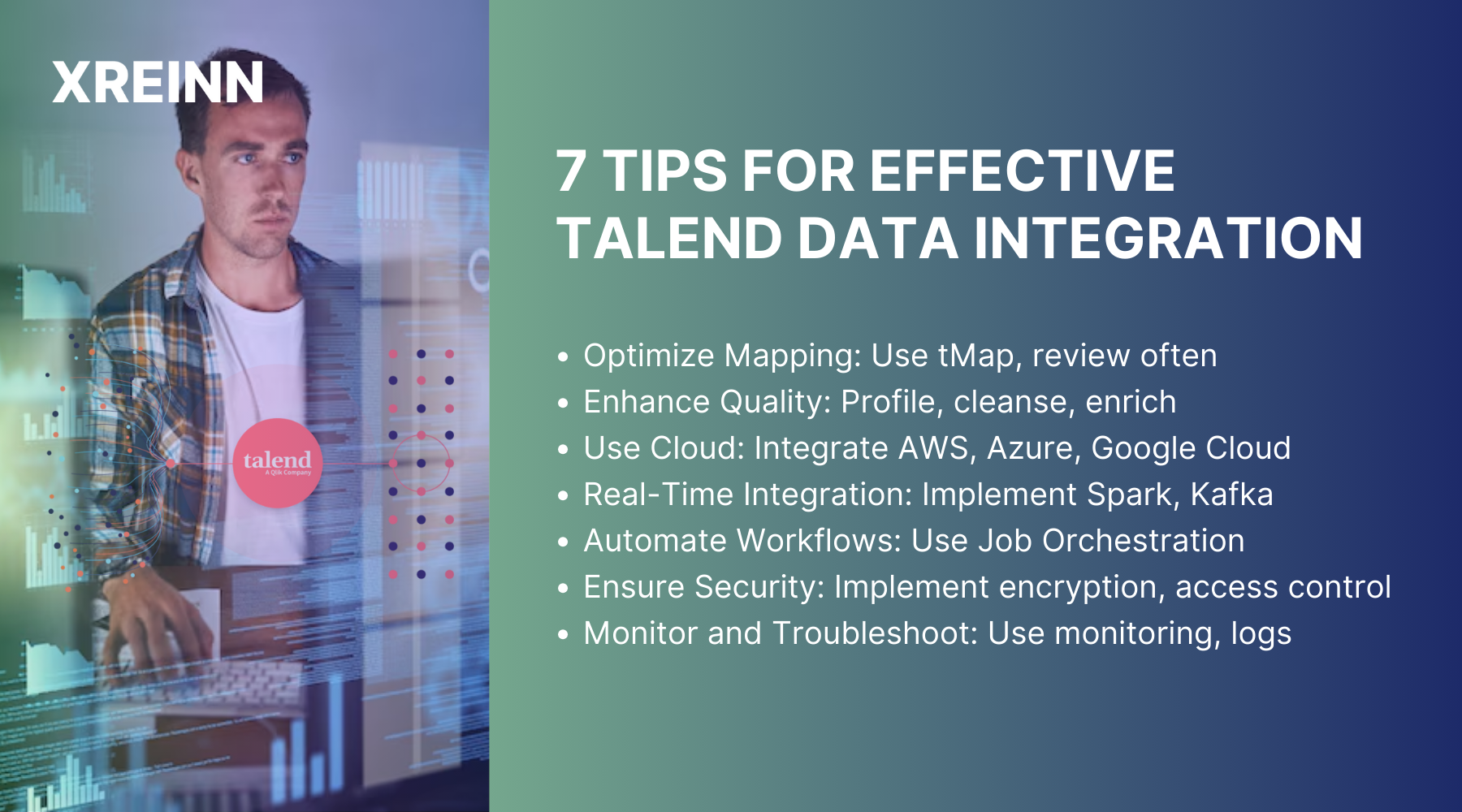Data Integration
7 Expert Tips for Mastering Talend Data Integration
Jul 09, 2024
Talend Data Integration is known for its strong capabilities allowing data professionals to handle complex integration tasks easily and efficiently. With Talend’s advanced features, you can ensure smooth data flow, maintain high data quality, and manage large volumes of data from various sources. These tools simplify your workflows and provide valuable understanding that drives smarter business decisions.
This guide explores seven expert tips to help you optimize your Talend Data Integration, transforming your approach and taking your data management skills to the next level.
What is Data Integration in Talend?
In Talend, data integration isn't just about moving data from one place to another; it's about creating a seamless flow that ensures data consistency, accuracy, and accessibility. Talend's architecture, including its components like Talend Studio, Talend Administration Center, and various Talend Data Integration tools, works together to turn raw data into useful information.
Is Talend Used for ETL?
ETL is key to data integration, including quality management, enrichment, and real-time processing. Talend integrates these seamlessly, ensuring continuous data flow and reliability. Unlike traditional ETL tools, Talend provides a more flexible and scalable environment. With Talend, you can manage real-time data processing, integrate with cloud services, and perform complex data transformations.
You can also use Talend’s ETL tools to streamline data pipelines, ensuring that data is not only moved but also transformed and validated to meet the highest standards.
Is Talend Similar to Tableau?
Though Talend and Tableau have different main functions, they work great together. Talend focuses on data integration and transformation, whereas Tableau is best in data visualization and analytics.
Integrating Talend with Tableau allows you to use the strengths of both tools. With Talend handling the heavy lifting of data preparation and Tableau providing powerful visual insights, you can achieve a seamless data-to-insights workflow.
7 Tips for Effective Talend Data Integration

1. Optimizing Data Mapping
Data mapping in Talend involves matching source data fields to target data fields. To optimize this process, use Talend's advanced features like the tMap component. This component allows for complex data transformations, including filtering, concatenation, and conditional expressions. By using Talend's expression builder, you can create complex mappings that ensure data integrity and consistency. Additionally, regularly reviewing and refining your mappings will help in maintaining optimal performance and accuracy.
2. Improving Data Quality
Data quality is also important for reliable analytics and decision-making. Talend offers a suite of tools for data profiling, cleansing, and enrichment. Start by using Talend Data Quality components to profile your data, identifying anomalies and inconsistencies. Implement data cleansing processes to correct errors and standardize formats.
For data enrichment, integrate external data sources to add valuable context to your existing datasets. Regularly monitoring data quality and setting up automated checks will ensure your data remains accurate and trustworthy.
3. Use Talend Cloud Integration
Talend’s cloud integration capabilities enable seamless connectivity with various cloud platforms like AWS, Azure, and Google Cloud. To use this, start by setting up Talend Cloud connectors to your preferred cloud services.
Use Talend's native cloud components to design and deploy cloud-native data pipelines. By doing so, you can take advantage of cloud scalability, performance, and security features. Advanced users often automate cloud data integration processes to handle large volumes of data efficiently and securely.
4. Implementing Real-Time Data Integration
Real-time data integration is essential for applications requiring up-to-the-minute data accuracy. Talend supports real-time data processing through its Spark Streaming and Kafka components. Configure Talend to connect with real-time data sources and set up streaming jobs that process data as it arrives. This setup ensures that your data remains current, allowing for real-time analytics and decision-making. Monitoring and tuning these real-time jobs will help maintain performance and reliability.
5. Automating Data Workflows
Automation in Talend can significantly reduce manual effort and improve efficiency. You can use Talend's Job Orchestration features to automate repetitive tasks and complex workflows. Create Talend Jobs that integrate various data sources, perform transformations, and load data into target systems.
Schedule these jobs using the Talend Administration Center to run at specified intervals or trigger them based on events. You can also use Talend's APIs to integrate workflow automation with other enterprise systems, further enhancing automation capabilities.
6. Ensuring Data Security and Compliance
Talend provides several features to secure data at rest and in transit. Implement encryption for sensitive data using Talend’s built-in encryption components. Use role-based access control to restrict data access to authorized users only.
Regularly audit data processes and maintain compliance with regulations like GDPR and HIPAA. Setting up automated compliance checks within Talend will help you in continuously monitoring and ensuring adherence to security standards.
7. Monitoring and Troubleshooting
Talend also offers monitoring tools that provide insights into job performance and system health. Set up alerts and dashboards to monitor key performance metrics. Use Talend’s logging features to track job execution details and identify issues.
For troubleshooting, analyze logs to pinpoint errors and bottlenecks. Regularly reviewing performance data and fine-tuning jobs will ensure optimal performance and quick resolution of issues.
Conclusion
Unlocking the full potential of Talend Data Integration can transform your data workflows, making them more efficient and improving data quality while providing the insights needed for smarter business decisions. Talend’s advanced features help you streamline complex integration tasks, handle large data volumes smoothly, and maintain high standards of data integrity.
By implementing these advanced strategies, you can achieve sustained growth, and operational excellence, and ensure your organization remains competitive in the ever-evolving data-driven world.

Data Analytics
Jun 27, 2024Master key concepts in data analytics with practical tips to enhance decision-making and achieve success in your projects and professional growth

Data Analytics
Jul 01, 2024Learn the essential stages of the data analytics workflow to turn your data into valuable business insights and drive growth.

